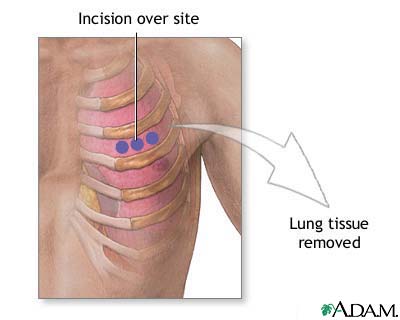Health Library
Open lung biopsy
Biopsy - open lung
An open lung biopsy is surgery to remove a small piece of tissue from the lung. The sample is then examined for cancer, infection, or lung disease.
Images


I Would Like to Learn About:
How the Test is Performed
An open lung biopsy is done in the hospital using general anesthesia. This means you will be asleep and pain free. A tube will be placed through your mouth down your throat, and into your windpipe (trachea) to help you breathe.
The surgery is done in the following way:
- After cleaning the skin, the surgeon makes a small cut in the left or right side of your chest.
- The ribs are gently separated.
- A viewing scope may be inserted through a small hole between the ribs to see the area to be biopsied.
- Tissue is taken from the lung and sent to a laboratory for examination.
- After surgery, the wound is closed with stitches.
- Your surgeon may leave a small plastic tube in your chest to prevent air and fluid from building up.
The breathing tube may not be able to be removed right after surgery. So, you may need to be on a breathing machine for some time.
How to Prepare for the Test
You should tell your surgeon if you are pregnant, allergic to any medicines, or if you have a bleeding problem. Be sure to tell your health care provider about all the medicines you take, including herbs, supplements, and those bought without a prescription.
Follow your surgeon's instructions for not eating or drinking before the procedure.
How the Test will Feel
When you wake up after the procedure, you will feel drowsy for several hours.
There will be some tenderness and pain where the surgical cut is located. Most surgeons inject a long-acting local anesthetic at the surgical cut site so that you will have very little pain afterward.
You may have a sore throat from the tube. You can ease the pain by eating ice chips.
Why the Test is Performed
The open lung biopsy is done to evaluate lung problems seen on x-ray or CT scan.
Normal Results
The lungs and lung tissue will be normal.
What Abnormal Results Mean
Abnormal results may be due to:
- Benign (not cancerous) tumors
- Cancer
- Certain infections (bacterial, viral, fungal, or parasitic)
- Lung diseases (fibrosis)
The procedure may help diagnose a number of different conditions, such as:
- Rheumatoid lung disease
- Sarcoidosis (inflammation that affects the lungs and other body tissues)
- Granulomatosis with polyangiitis (inflammation of the blood vessels)
- Pulmonary hypertension (high blood pressure in the arteries of the lungs)
Risks
There is a slight chance of:
- Air leak
- Excess blood loss
- Infection
- Injury to the lung
- Pneumothorax (collapsed lung)
Related Information
Lung needle biopsyCancer
Lung disease
X-ray
CT scan
Benign
Simple pulmonary eosinophilia
Disseminated tuberculosis
Solitary fibrous tumor
Malignant mesothelioma
Aspiration pneumonia
Lung cancer - small cell
Pulmonary tuberculosis
Rheumatoid lung disease
Sarcoidosis
Viral pneumonia
Granulomatosis with polyangiitis
References
Chernecky CC, Berger BJ. Biopsy, site-specific - specimen. In: Chernecky CC, Berger BJ, eds. Laboratory Tests and Diagnostic Procedures. 6th ed. St Louis, MO: Elsevier Saunders; 2013:199-202.
Wald O, Izhar U, Sugarbaker DJ. Lung, chest wall, pleura, and mediastinum. In: Townsend CM Jr, Beauchamp RD, Evers BM, Mattox KL, eds. Sabiston Textbook of Surgery. 21st ed. St Louis, MO: Elsevier; 2022:chap 58.
BACK TO TOPReview Date: 10/10/2022
Reviewed By: Mary C. Mancini, MD, PhD, Cardiothoracic Surgeon, Shreveport, LA. Review provided by VeriMed Healthcare Network. Also reviewed by David C. Dugdale, MD, Medical Director, Brenda Conaway, Editorial Director, and the A.D.A.M. Editorial team.
 | A.D.A.M., Inc. is accredited by URAC, for Health Content Provider (www.urac.org). URAC's accreditation program is an independent audit to verify that A.D.A.M. follows rigorous standards of quality and accountability. A.D.A.M. is among the first to achieve this important distinction for online health information and services. Learn more about A.D.A.M.'s editorial policy, editorial process and privacy policy. A.D.A.M. is also a founding member of Hi-Ethics. This site complies with the HONcode standard for trustworthy health information: verify here. |
The information provided herein should not be used during any medical emergency or for the diagnosis or treatment of any medical condition. A licensed medical professional should be consulted for diagnosis and treatment of any and all medical conditions. Links to other sites are provided for information only -- they do not constitute endorsements of those other sites. No warranty of any kind, either expressed or implied, is made as to the accuracy, reliability, timeliness, or correctness of any translations made by a third-party service of the information provided herein into any other language. © 1997- 2024 A.D.A.M., a business unit of Ebix, Inc. Any duplication or distribution of the information contained herein is strictly prohibited.
